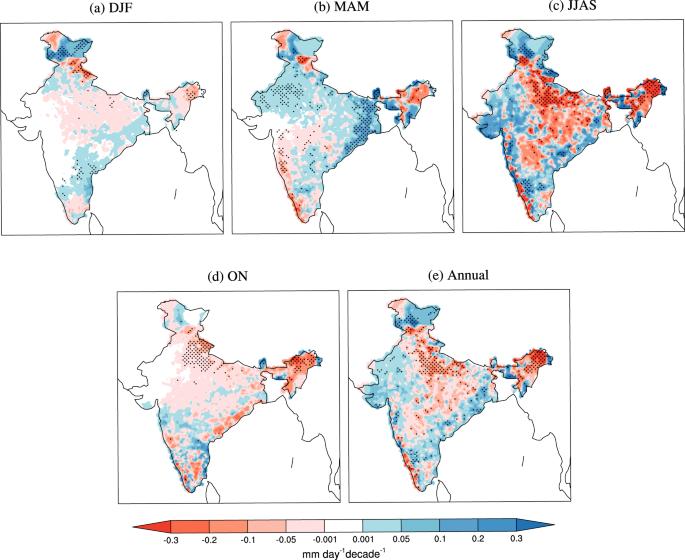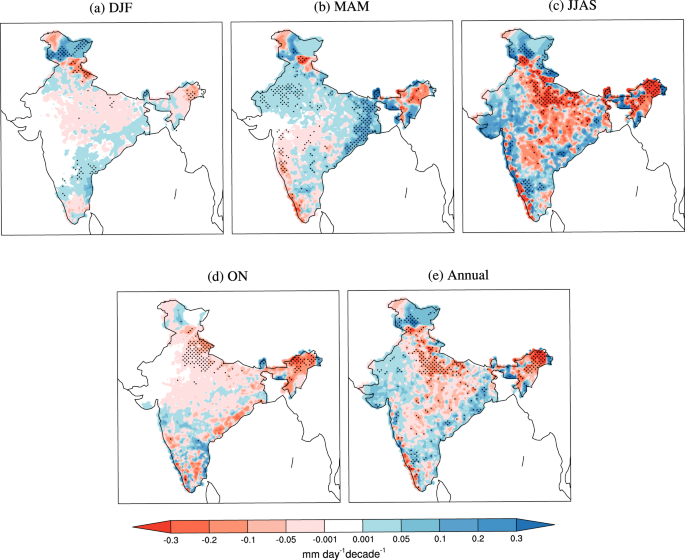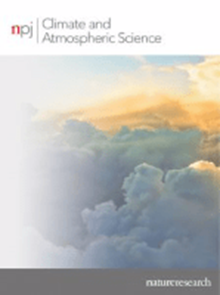印度每日连续降雨地区气候特征的近期变化
IF 8.4
1区 地球科学
Q1 METEOROLOGY & ATMOSPHERIC SCIENCES
引用次数: 0
摘要
本研究记录了气候特征(1951–1980)和降雨特征的最近变化(1981–2020),考虑到在印度所有季节观测到的几乎全谱的降雨事件规模(每日连续降雨面积(CRA)事件)。研究发现,季风季节的低频甚大CRA(~天气尺度)贡献了年降雨量的50%左右。然而,小型CRA(孤立雷暴)是最频繁的日常降雨事件(约为年频率的70%),因此对雨水灌溉的农业实践很重要。有充分证据表明,季风季节的大范围干旱趋势表现在年降雨量趋势上,但其幅度有所减小,说明了其他季节的补偿作用。空间综合年度统计数据显示,与基准期相比,最近一段时间的降雨量和降雨事件发生频率没有显著变化。然而,季节性地,季风前的降雨量显著增加。每年,由于季风前和季风降雨量的显著增加,特大CRA(EHR)事件的数量显著增加约55%。在所有季节,与基准期相比,小型极重CRA显著增强了50-200%。此外,除冬季外,区域类别大(~中尺度对流复合体(MCC))的降雨事件在所有季节都有所增强。因此,减少雨水灌溉农业实践的不确定性,更好地预测EHR,以制定有效的气候变化缓解战略;还需要对季风季节以外的过程和天气尺度以外的过程进行研究。本文章由计算机程序翻译,如有差异,请以英文原文为准。


Recent changes in the climatological characteristics of daily contiguous rain areas over India
This study documents the climatological feature (1951–1980) and recent changes (1981–2020) in rainfall characteristics considering the observed nearly full spectrum of rain event sizes (daily contiguous rain area (CRA) events) in all seasons over India. It is found that the low frequency very large CRA (~synoptic scale) from monsoon season contributes ~50% of annual rainfall. However, the small-sized CRA (isolated thunderstorms) are the most frequent daily rain events (~70% of annual frequency) and hence are important for rain-fed agricultural practices. The well-documented widespread drying trend in the monsoon season has manifested in the annual rainfall trend but with reduced magnitude illustrating the compensatory effect from other seasons. Spatial aggregated annual statistics show that there is no significant change in rainfall amount and frequency of occurrence of rain events in the recent past compared to the base period. However, seasonally the pre-monsoon rainfall amount has increased significantly. Annually, the number of extremely heavy CRA (EHR) events have significantly increased by ~55% owing to a significant increase in pre-monsoon and monsoon rainfall. In all seasons, small-sized extremely heavy CRA has intensified substantially by 50–200% as compared to the base period. Additionally, the rain events from areal category large (~Mesoscale Convective Complexes (MCC)) have intensified in all seasons except winter. Thus, to decrease the uncertainty in rain-fed agricultural practices and better prediction of EHR to develop effective climate change mitigation strategies; process studies beyond monsoon season and processes other than synoptic scales are also required.
求助全文
通过发布文献求助,成功后即可免费获取论文全文。
去求助
来源期刊

npj Climate and Atmospheric Science
Earth and Planetary Sciences-Atmospheric Science
CiteScore
8.80
自引率
3.30%
发文量
87
审稿时长
21 weeks
期刊介绍:
npj Climate and Atmospheric Science is an open-access journal encompassing the relevant physical, chemical, and biological aspects of atmospheric and climate science. The journal places particular emphasis on regional studies that unveil new insights into specific localities, including examinations of local atmospheric composition, such as aerosols.
The range of topics covered by the journal includes climate dynamics, climate variability, weather and climate prediction, climate change, ocean dynamics, weather extremes, air pollution, atmospheric chemistry (including aerosols), the hydrological cycle, and atmosphere–ocean and atmosphere–land interactions. The journal welcomes studies employing a diverse array of methods, including numerical and statistical modeling, the development and application of in situ observational techniques, remote sensing, and the development or evaluation of new reanalyses.
 求助内容:
求助内容: 应助结果提醒方式:
应助结果提醒方式:


